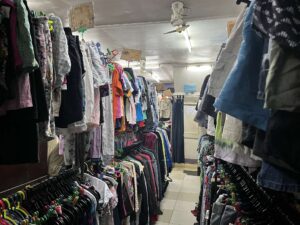
 The popularity of ukay-ukay in the Philippines has increased significantly since the COVID-19 pandemic, and it has continued to expand ever since. This is due to the fact that it is sustainable and offers low prices for ukay-ukay products. Additionally, there was a trend of thrifting among young people. (Fitri Astuti Lestari & Ratna Asmarani, 2021). What has contributed to its rise as a trend among the youth?
The popularity of ukay-ukay in the Philippines has increased significantly since the COVID-19 pandemic, and it has continued to expand ever since. This is due to the fact that it is sustainable and offers low prices for ukay-ukay products. Additionally, there was a trend of thrifting among young people. (Fitri Astuti Lestari & Ratna Asmarani, 2021). What has contributed to its rise as a trend among the youth?
Aside from its sustainable practices, thrifting motivation is driven by the desire to reduce expenses but still look unique, stylish and different, as well as the emergence of awareness in protecting the environment. (Fitri Astuti Lestari & Ratna Asmarani, 2021). On the other hand, questions have arisen, particularly in light of the emergence of ukay-ukay, such as in how did it start? When did it start? For what reason did it start? The ukay-ukay trend that has been going on for years in the Philippines has a deeper history than only it starting due to its sustainability, but it was also strongly looked down upon.
Before the ukay-ukay trend was born, there were many stories about ukay-ukay and these were fanned by newspaper articles on irregularities in the distribution of relief goods for calamity victims. It is said that these clothing donations were put together with the relief goods for whatever calamity there was. (Valdez et al., 2014) It was not because of the social standing or the fact that it was used items that the ukay-ukay industry fell into disfavor but because the legalization of the ukay-ukay business became an issue amidst the outcry of customers as well as establishments selling brand new clothes.
The ukay-ukay industry made other businesses lose their customers because of the ongoing outcry of the establishments and the people selling brand-new items. In 2002, President Gloria Macapagal-Arroyo banned the entry and sale of ukay-ukay items in the Philippine market. This has created disparity and discontentment among the people who valued ukay-ukay goods as it was the most affordable in the market.
In defense of legalization, Macairan wrote a proposal to legalize the importation of ukay-ukay. Accordingly, Customs Commissioner Angelito Alvarez, together with Oriental Mindoro Representative Rey Umali, Leyte Representative Andres Salvacion, and Batangas Representative Tomas Apacible, worked on a proposal to legalize the importation and selling of used clothes, popularly known as ukay-ukay. (Valdez et al., 2014).
According to them, the ukay-ukay industry is not something that should be considered bad; rather, they consider it to be something that should be considered beneficial because If the importation of used garments is finally allowed, the country can earn revenue amounting to Php 700 millions from taxes and duties annually. There is an overall agreement among those in the clothing sector that the growing popularity of the ukay-ukay industry is not a cause for concern.
Alvarez also noted that the ukay-ukay industry helped in creating jobs for many Filipinos. (Valdez et al., 2014) If the ukay-ukay industry were still illegal, consumers would be compelled to buy fast fashion, which is likewise affordable but an unethical business. However, the ukay-ukay industry has grown and is more popular than it has ever been, helping millions of Filipinos with its less costly and more environmentally friendly method of purchasing used items.